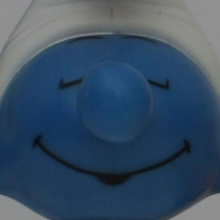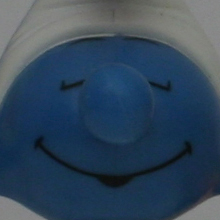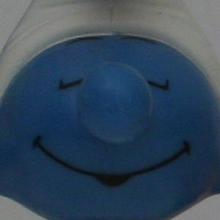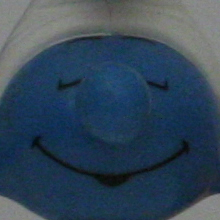Canon Digital Rebel XT: Hardly an Entry-Level DSLR
by Stephen Caston on May 3, 2005 12:05 AM EST- Posted in
- Digital Camera
Noise
The noise test consists of pictures of our studio shot taken at increasing ISO levels to show the effect on the image. The pictures were taken after resetting the camera to its factory default settings. The camera is then set to record with the highest quality JPEG option with manual WB. Click on a 100% crop below to view the full-size image. All images were shot in Aperture-priority mode, Parameter 2, and sRGB.We mentioned early on in the review that the 350D is much more like the 20D than the 300D. As the crops above demonstrate, it is virtually impossible to see any difference in noise levels between the 350D and the 20D. Probably one of the first things that you will notice in looking at our sample images is that the 350D seems to have done a considerably better job metering our studio shot. We have no explanation for this, considering that the shot was set up the same. Perhaps the slight differences in framing could account for it. In our experience with the 350D, we have been very impressed with the evaluative metering system, even in backlit conditions. However, both cameras are capable of some incredibly low-noise images. It isn't until ISO 400 that either camera starts producing noticeable noise. Also, there isn't any discoloration or noteworthy detail loss until ISO 1600. Of course, the 20D has the advantage of using ISO 3200 while the 350D maxes out at 1600. If you shoot subjects frequently in very low light environments, it might be worth it to take a look at the 20D instead. Otherwise, the absence of ISO 3200 probably won't be a concern for most people.
For another comparison, below are rollovers of the 350D and 300D. Roll your mouse over the original 350D crop to see the 300D crop.
| ISO 100 |  Hold mouse over image. |
| ISO 200 |  Hold mouse over image. |
| ISO 400 |  Hold mouse over image. |
| ISO 800 |  Hold mouse over image. |
| ISO 1600 |  Hold mouse over image. |
Compared to the original Rebel (300D), the 350D shows a dramatic improvement. From ISO 100 to 200, they both show relatively low noise. However, from ISO 400 to 800, we can see that the 300D begins to show more noise than the 350D. In fact, at ISO 800, the 350D image is comparable to ISO 400 on the 300D. At ISO 800 on the 300D, the image is characterized by discoloration and grain while the 350D image remains smooth and clear. At ISO 1600, there is no contest; the 350D retains clarity with minimal discoloration while the 300D produces an image with a "webcam-like" quality.
















27 Comments
View All Comments
6000SUX - Sunday, May 8, 2005 - link
Thanks for a great review. Based on this one, I went to some other sites like dpreview.com, checked out lots of sample pictures etc. against competitors like the D70 and decided to take the plunge. All I can say is, this camera's fantastic. It's easy even for a relative newbie like me to get up to speed and take really great pictures.Now I have a great camera with which to take pictures of my first child. Thanks again.
stephencaston - Thursday, May 5, 2005 - link
#23, Unfortunately, since the digicam section is still relatively new, we don't have a lot of places to get products right now (lenses). We have been able to do Canon SLR reviews simply because we already have lenses. Don't worry, we are planning on covering the new Nikon DSLRs as soon as we can get them.Stephen
sgtroyer - Thursday, May 5, 2005 - link
I've got to add to the calls for a Nikon DSLR review. It's a pretty glaring omission given the reviews of the Canon 300D, 20D, and 350D, but no Nikon. The D70 is a fantastic camera, far better than the 300D for marginally more money. The D50 will provide even better value. Isn't reviewing only Canon DSLRs sort of like reviewing only Nvidia GPU's or Intel processors?stephencaston - Thursday, May 5, 2005 - link
Keep in mind that this isn't a "real world" battery test. We literally sat down with the camera and took 3,818 frames in one session.Ender78 - Thursday, May 5, 2005 - link
The battery life stated here seems to be a little off. I will have to test, but I dont believe my camera has anywhere close to the stated battery life.gplracer - Wednesday, May 4, 2005 - link
Nice review. I decided on the 20D over the 350 because of the size, feel, and the controls. The wheel in the back of the 20D is so much better than the controls on the 350. I am sure picture quality is close.brownba - Wednesday, May 4, 2005 - link
even my sd300 has this 'rattle.'i too assume it's for determining position.
that's the coolest thing - when you're in clock mode, if you swiftly move the camera, it will change the color of the clock.
shuttleboi - Tuesday, May 3, 2005 - link
From what I've read, the viewfinder on the XT is even smaller than the tiny one I have on my 300D. I also own a Canon film SLR, and the viewfinder in that is freaking huge compared to the one in my 300D. When you have a wide-aperture lens (larger than f2.8), then you will want a large viewfinder to see if you are focusing correctly, otherwise it is very easy to get the focus plane locked with the narrow depth of field.shuttleboi - Tuesday, May 3, 2005 - link
#13: if the XT is like my 300D, then that rattling sound is the part of the camera that determines if you are holding the camera vertically or horizontally. It is normal.STaSh - Tuesday, May 3, 2005 - link
No idea...I have a 20d.